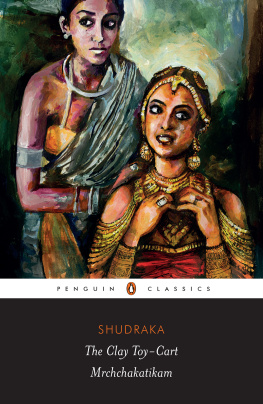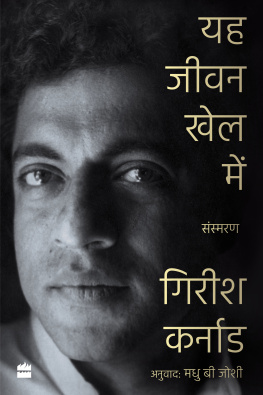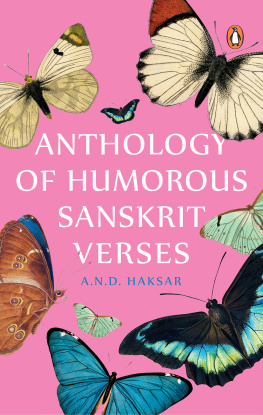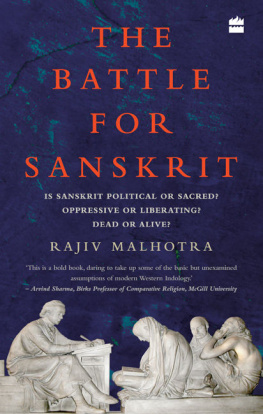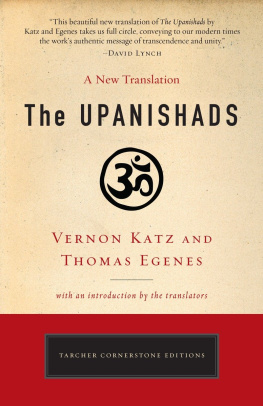SHUDRAKA is regarded as one of the foremost Sanskrit dramatists. Although his work has been lauded for centuries, the truth of his real identity remains a mystery.
PADMINI RAJAPPA studied Sanskrit under the private guidance of the teachers of the department of Sanskrit of the University of Poona and at the Bhandarkar Oriental Research Institute. She received a PhD degree in history from the University of Bombay. In 2014, she won the Sahitya Akademi award for translating Banabhattas Kadambari, a seventh-century Sanskrit prose work, into English.
Introduction
Mrchchakatikam, or The Clay Toy-Cart, is a work almost unique in Sanskrit literature, a work of drama as renowned for its ingenious plotting and memorable characters as it is for the mystery that shrouds the identity of its author.
The very title is unusual; plays in Sanskrit are usually named after the principal character(s) or else the main event in the story. Further, the play boasts not only an unusually complex hero, the impoverished brahmin merchant Charudatta who is dutiful and impulsive and generous to a fault, but also a unique heroine, the beautiful cultured, progressive and fiercely independent courtesan, Vasantasena. By naming his play Mrchchakatikam, Shudraka indicates right at the outset that the clay toy-cartwhich appears only at the beginning of Act VIforms the pivotal agent of suspense in this gripping tale of love, political intrigue, violent crime and social commentary.
The titular cart is introduced, quietly and cleverly, in a rather poignant scene: Rohasena, the young son of Charudatta, is found crying for a golden cart, just like the one his playmate has. He refuses to play with the toy-cart that the maid Radanika has made for him. Vasantasena, watching the scene, is overwhelmed with pity and tenderness. She at once removes her jewellery, fills the toy-cart with it and hands it over to the child, telling him that he can now have his own gold cart made out of her jewels. This small episode will set into motion a dramatic sequence of events with grievous repercussions; Rohasenas seemingly innocent toy-cart thus earns its stripes as an apt title for Shudrakas play.
Nonetheless, to fully understand this plays iconic status in the Sanskrit canon as well as to grasp what makes it so fascinating and complex, it would be both useful and revealing to contextualize it first within the broader framework of Sanskrit drama.
Evolution of Sanskrit drama
In the Natyashastra of Bharata there is an account of the origin of natya, or drama. According to it, when the Krita Yuga ended and the Treta Yuga began, vulgarity, unruly passions, greed, confusion born of jealousy, and anger also made an appearance, leading to flawed happiness, pleasures having become mixed with pain. Indra, the leader of the devas, approached Brahma, it is said, and asked him for a kridaniyaka, a plaything, good for the eyes and good for the ears. Indra wished Brahma to create a new Veda, a fifth one meant for all the people, including the lower orders. Brahma, the knower of Truth, agreed and, meditating upon the four Vedas, created the Natya Veda, full of the import of the scriptures, conducive to righteousness, wealth and glory as well as to the development of all the arts and crafts. He introduced historical tales as well as instructions for future generations of mankind by drawing on the various elements of the Vedas, such as the recitative texts from the Rig Veda, the music from the Sama Veda, the acting from the Yajur Veda, and emotions and sentiments from the Atharva Veda. Having created the Natya Veda, Brahma gave it to Indra saying that he had created the historical tales too to be used for production with the help of the gods (G.K. Bhat, Bharata-Natya-Manjari: A Selection from Bharatas Natyasastra, Origin of the Natyaveda, pp. 46; Introduction, p. 1).
Discounting the hand of Brahma, Bharata is quite close to the truth when he talks of the natya as born out of the elements found in the four Vedas and nourished into maturity by the rich tales of the Itihasas or the epics and the Puranas, including the cult of VishnuKrishna.
* * *
In a few of the hymns of the Rig Veda, fifteen in number according to A.B. Keith, there are dialogues, such as the one between King Pururavas and Urvashi in which the king chides the apsara for her inconstancy, no doubt to prevent her from leaving him, an attempt in which he fails; or the one carried on by Sage Agastya with his wife Lopamudra and their son. It is very likely that in the recitation of these hymns different individuals would have spoken the words of the different participants of the conversation (A.B. Keith, The Sanskrit Drama, p. 14).
However, there is something enigmatic about these dialogue hymns; strangely the traditional interpreters of Vedic literature like Sayana (a thirteenth-century commentator) seem to be at a loss to understand the ritual purpose of these dialogue hymns. Perhaps they were never recited in the actual performance of any ritual; perhaps they were just a different form of poetry which disappeared in later Vedic times.
It was Max Mller, the great Indologist, who brought at least one of these dialogue hymns back into relevance, the one in which there is a dispute between Indra and the Maruts, the wind deities (Rig Veda,1.165). Indra accuses the Maruts of deserting him in the fight against the demon Vrtra. The Maruts, however, succeed in placating Indra in the end. Mller believed that this hymn was not only repeatedly recited at the sacrifices in honour of the Maruts but it might even have been acted out by two groups, one representing Indra and the other the Maruts, all as part of the ritual (The Sanskrit Drama, p. 15). Perhaps we have here the earliest tentative beginnings of Sanskrit drama.
We are on firmer ground in the rituals of the Yajur Veda. In the meticulous performance of these rituals, accompanied by elaborate ceremonies, complex dramatic representation became noticeable. The rituals demanded more than mere singing of songs or recitations in praise of the deities; it required the participants to assume different parts, take on identities other than their own. Consider, for instance, the episode of buying soma for the soma sacrifice. The soma seller is not paid his price but instead pelted with clods of earth miming the mythological episode of getting soma from its guardians, the gandharvas (celestial musicians) (The Sanskrit Drama, p. 23).
In the mahavrata, which is a ritual for increasing the power of the sun after the winter solstice (described in the Katha Aranyaka and the Aitareya Aranyaka), two men struggle with each other to get at a round piece of white leather no doubt symbolizing the sun. Of the two participants one is white, an Aryan Vaishya, and the other black, a Shudrathe one symbolizing summer and the other, winter. The colour-coding should not offend us; it should be seen as a very early attempt at personification: the dark man standing for the darkness of winter days and the light-skinned man for the brightness of summer with a reinvigorated sun (

